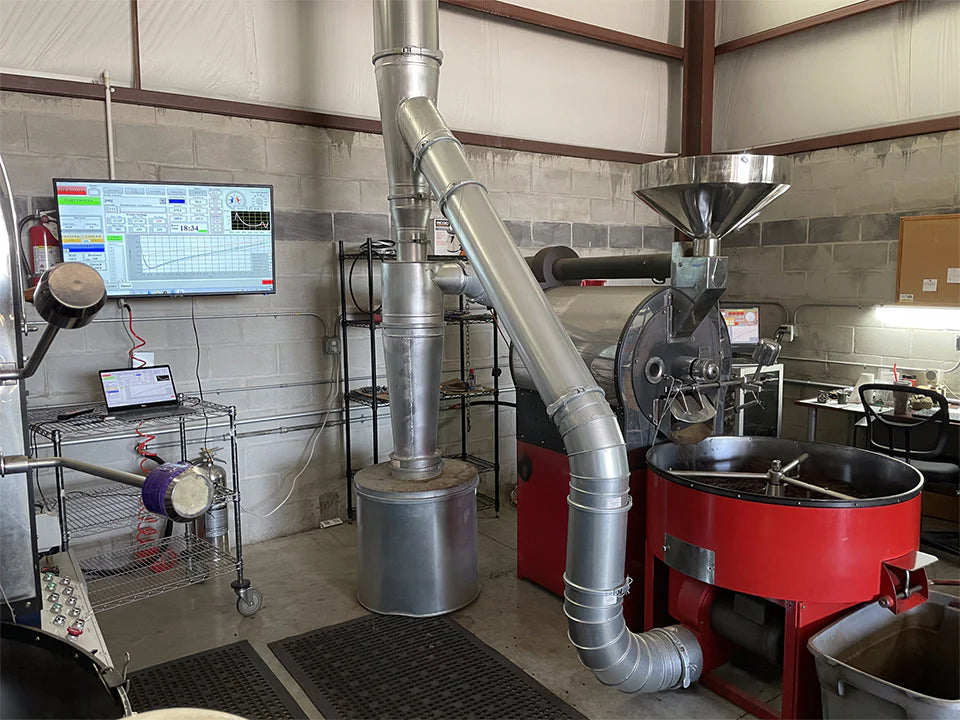Latitude

There are four major commercial processes used to remove caffeine from coffee. Conventional decaffeination uses the chemical Methylene Chloride, "Natural" decaffeination uses the chemical Ethyl Acetate. Water decaffeination uses water and Carbon Dioxide decaffeination uses carbon dioxide. Each of these methods does a good job of removing the caffeine from coffee (to sell a coffee as decaffeinated it must be at least 97% caffeine free). However, there are significant differences in the taste of the decaffeinated product, in the residual chemicals remaining in the beans, and in the effect on the environment
WATER DECAFFEINATION
For most people water decaffeination is synonymous with Swiss Water Process, but of course Swiss Water Process is merely a trademarked name. A water process decaffeination plant starts by soaking coffee beans in pure water. The liquid is drained off, and the coffee is thrown away, because it is now flavorless. The liquid solution, however, is full of both coffee flavors and caffeine. The liquid is then passed through a carbon filter, which removes the caffeine but not the flavor components. This flavor-saturated liquid is then poured onto a new batch of coffee. Because the liquid is already full of coffee flavors, it doesn't extract any additional flavor from the coffee beans. It does, however, extract the caffeine. This cycle of soaking, then filtering out the caffeine, can be repeated indefinitely.
The advantages of the water process over conventional methods is that no chemicals are used, so no residual chemicals are left in the beans. The environment, likewise, remains unaffected. Most people seem to agree that the water process produces a more flavorful cup of coffee. Unfortunately water process coffee is also more expensive. In fact, Swiss Water Processed coffee is as much as four times as expensive as conventionally decaffeinated.
CONVENTIONAL DECAFFEINATION
In this process coffee beans are first soaked with water to make them swell, opening pores and hastening the extraction process. It also "presoaks" the caffeine into the water, which facilitates the extraction process. The beans are then immersed in the solvent Methylene Chloride (CH2Cl2), which extracts the caffeine from the coffee beans by bonding to the caffeine molecules. The decaffeinated beans are run through water and steam treatments, evaporating the caffeine laden solvent out of the beans. Since Methylene Chloride actually bonds to the caffeine instead of just dissolving it, the caffeine evaporates with the solvent and doesn't stay on the coffee. The solvent is later processed to extract the caffeine for use in other products. (In decaffeination plants, the sale of the residual caffeine can be a greater source of revenue than the decaffeination fees.)
Although Methylene Chloride levels in the coffee bean are reduced to residual levels that are "legally safe" (the FDA has set a maximum allowable level of 10 parts per million), more and more health conscious consumers are considering these residues unacceptable. The European Community recently banned the use of Methylene Chloride for coffee decaffeination. Although measures are taken to recycle as much of the chemical as possible, the evaporated chemical that escapes into the atmosphere during processing may be harmful to the ozone layer.
Finally, some consumers criticize the flavor of coffee decaffeinated with Methylene Chloride is somewhat flat and tasteless.
ETHYL ACETATE DECAFFEINATION
Coffee decaffeinated using this process is frequently referred to as "Naturally Decaffeinated" because Ethyl Acetate (CH3CO2C2H5) can occur naturally in orange rinds and other fruits including, sugar cane. The cost of using naturally occurring extract is high and so the Ethyl Acetate most widely used in decaffeination is produced chemically through fermentation. The decaffeination process is essentially the same as in conventional Methylene Chloride decaffeination, except Ethyl Acetate replaces Methylene Chloride as the solvent.
While no ozone issues have arisen in relation to this chemical, there are still chemical residues remaining in the coffee beans (10 ppm max). The criticism of less flavorful coffee is leveled at this process as well. Ethyl Acetate is slightly more expensive than Methylene Chloride, but the marketing advantage in the ability to label the beans "naturally decaffeinated" is a powerful incentive.
CARBON DIOXIDE (CO2) DECAFFEINATION
CO2 decaffeination is based on the simple principle of "like dissolves like". Pressurized CO2 is a dense fluid with a molecule that (like caffeine) is small and non-polar (non-polar molecules have no electrical charge). The flavor components in coffee are a combination of carbohydrates (starches and sugars) and peptides (proteins), both of which are large, polar molecules.
In the CO2 decaffeination process, water soaked coffee beans are placed in a stainless steel container or extractor. The extractor is then sealed and liquid CO2 is injected. The CO2 acts as the solvent to draw and dissolve the caffeine from the coffee beans, leaving the larger flavor components behind. The caffeine laden CO2 is then transferred to another container. Here the pressure is released and the CO2 returns to its gaseous state, leaving the caffeine behind. The caffeine free CO2 gas is pumped back into a pressurized container for reuse.
Some taste tests show CO2 decaffeination produces the most flavorful decaffeinated coffee. There are no harmful chemicals or by-products of the process. Unfortunately, the cost of building a CO2 decaffeination plant is quite high, so this process is primarily used to decaffeinate large volumes of commercial grade coffee. Because of the growing market for a safe and flavorful decaffeinated product, CO2 decaffeinated specialty grade coffees are becoming more readily available. There is at least one CO2 decaffeination plant in Germany that has been organically certified and can decaffeinate specialty grade coffees in relatively small container load (38,000 lb) quantities.
Related articles
Fall in Love with Flavor: The Story Behind Our Seasonal Coffee Blends
Fall in love with cozy flavors! Discover how our seasonal blends like Pumpkin Pie & Caramel Apple are crafted with...
Behind the Scenes: A Look Inside Coffee Production at Latitude HQ
Step inside Latitude HQ and see how we roast, bag, and package every coffee and K-Cup with purpose, quality, and...



